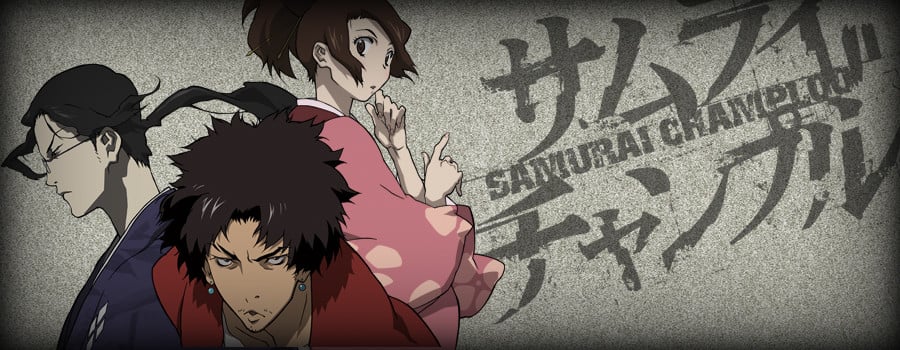Samurai Champloo (TV)
Go back to Samurai Champloo main page
Champloo is another way of writing chanpuru, an Okinawan word for "mixed together" - and also a local delicacy made of tofu and vegetables.
In Tokugawa times, men could divorce women with a simple letter of divorce (mikudarihan). The only option for women was to find a "Kakekomidera" (literally "run-into-hiding temple") that was licensed to give runaway women sanctuary (the first and most famous being the Tokiji, in Kamakura). After three years in hiding, the marriage was considered dissolved.
Xavier III’s, hm, “antiques” are all props in extremely famous traditional tales. It’s the equivalent of peddling off William Tell’s apple and Washington’s little hatchet.
Shoutoku Taishi is Prince Shotoku (573-621), Empress Suiko’s nephew and regent, who was the effective founder of Japan’s Imperial system, being credited by the "Kojiki" with centralizing the administration, importing Chinese culture and bureaucracy, and enacting the “17-article Constitution,” the first codification of law in Japanese history. He was also instrumental in furthering Buddhism in Japan and as such, he is considered a Buddhist saint (he was canonized as the Miryoku Kannon Bosatsu). I’ll admit to not quite getting the denture joke, although teeth are common Buddhist relics (teeth and hyoid bones tend to survive cremation).
Mouri’s three arrows refer to a story well know to every Japanese schoolchild, the "mitsuya no kyokun" (the "Three Arrow Lesson"), in which Mouri Motonari (1497 - 1571 ) the daimyo (feudal lord) of Aki domain (around Hiroshima) taught his children that while one arrow is easy to break, three tied together aren’t, hence they should stick together. (Yes, it should sound familiar: this story derives from an Aesop fable. It also appears in Kurosawa’s “Ran”).
Ikkyuu Oshou’s tiger folding screen refers to one of the many tales associated with Ikkyuu (1394-1481), a Buddhist monk, poet and famous wit and trickster: asked by the prank-prone Shogun to capture a troublesome tiger, and shown the screen painting instead, Ikkyuu grabbed some rope, made a noose and said “Okay, I’m ready. Please, Your excellency, if you would just chase the tiger into the garden, I’ll rope it.”
Hideyoshi’s straw sandals refer to the famous tale in which a young Toyotomi Hideyoshi (1536-1598) the second of the three ”Great Unifiers” was placed in charge of caring for the straw sandals of the First Unifier, Oda Nobunaga (1534-1582). Nobunaga, finding his sandals warm one morning, scolded Hideyoshi for sitting on them. Hideyoshi replied “no, sire, as the morning was cold, I warmed them up in my bosom” (an exceedingly devoted –or derriere-kissing- thing to do, as footwear was considered very polluting indeed).
The Shimabara Rebellion referred to throughout the series was an uprising near Nagasaki in 1637 which resulted in the beheading of nearly 40,000 Christians. Nagasaki has since been a stronghold of Christianity to this day.
The character Manzou "the Saw" (the secret policeman) is a parody of the live action character Hanzou "the Razor" Itami; three movies from the series were licensed and translated by AnimEigo.
In the end of episode nine Mugen is seen smoking marijuana in a cloud of purple haze, a reference to the Jimmy Hendrix song of the same name.
The plot in episode 7 bears a strong resemblance to the plot of the 8th episode of Cowboy Bebop "Waltz For Venus".
In episode 11: Gamblers and Gallantry (Fallen Angels), The name of the beetle Mugen trains is Rodriguez.
In episode 18, a character with wild, white hair wanders around Hiroshima, appraising the works of graffiti that have been drawn around the city. This character bears a striking resemblance to Andy Warhol in both his appearance and effeminate, introverted personality. He introduces himself as Andou-ya no Uohoru, which sounds similar to Andy Warhol.
In episode 19, Xavier III has among his treasures several famous paintings. One is Birth of Venus by Botticceli, another is Liberty Leading the People by Delacroix.
In episode 23, Baseball Blues, the "catcher" for the Japan team has a face drawn on it called a henohenomoheji. It is made using the hiragana characters for the respective syllables.
In episode 24, Mugen tells of meeting an old man who Mugen recalls saying something like "Can you not see this box with the Shogun's crest?" while displaying said box, whom Mugen then killed. This is the tag line from the extremely popular period drama television show _Mito Komon_ (spawned from the movie series of the same name), which ran for twenty-eight years and 800 episodes, starting in 1969. The character is a former vice shogun, who travels incognito investigating crime and corruption, and whose retainer reveals his identity with the tag line and the crested box at the crucial moment.
| You can contribute information to this page, but first you must login or register |
| DISCLAIMER | add information | report an error | lookup sources |

